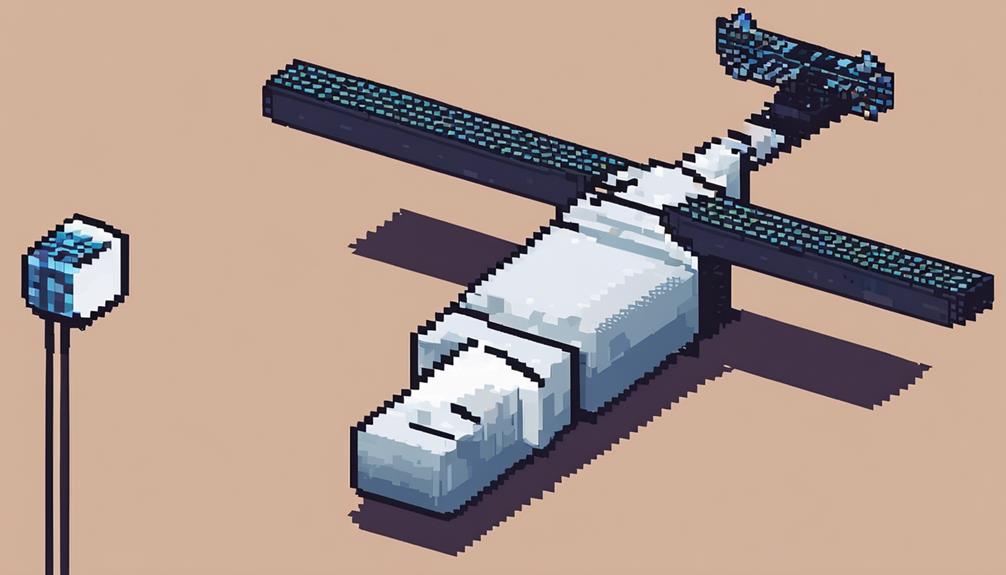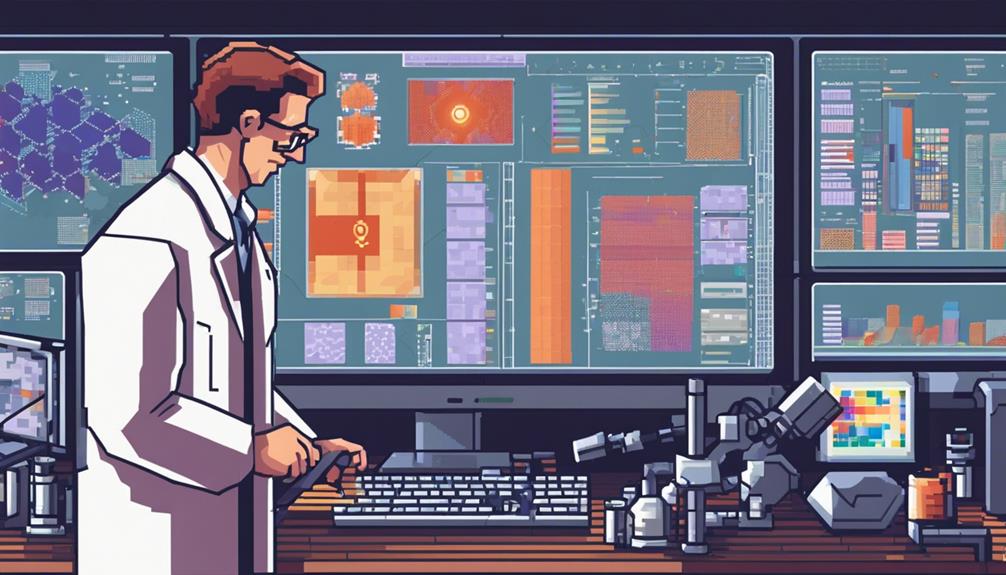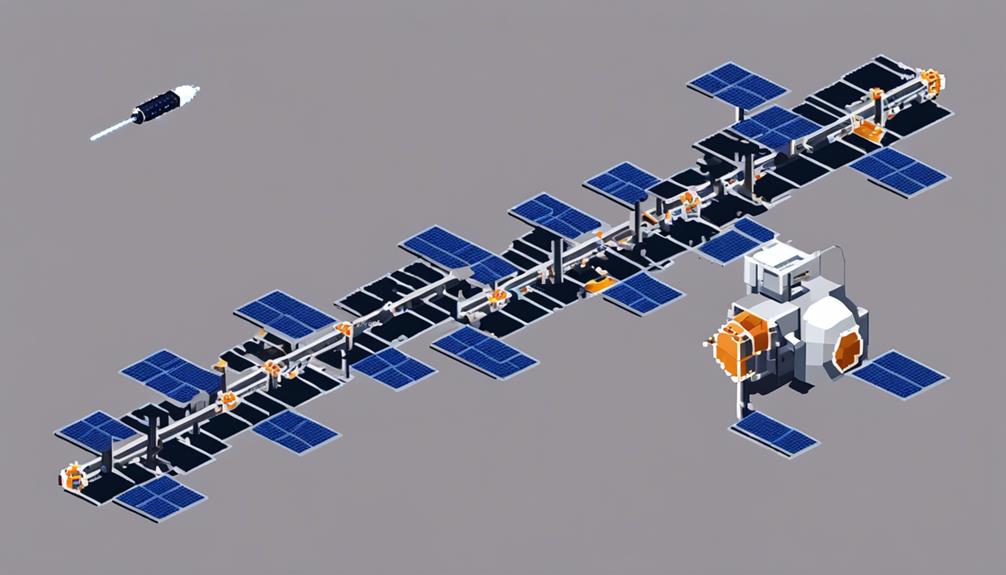The evolution of satellite materials is a critical aspect of advancing space technology. With the ever-growing demands for satellites to withstand harsh conditions and maintain peak performance over extended periods, the development of next-generation materials has become paramount. From cutting-edge composites to novel nanomaterials and intelligent alloys, the quest for materials that can revolutionize satellite design and functionality is ongoing. The intricate interplay between material science and space exploration opens doors to a realm of possibilities that promise to reshape the future of satellite technology.
Key Takeaways
- Utilization of advanced fibers and nanoscale components for enhanced satellite performance.
- Development of lightweight yet durable materials resistant to extreme space conditions.
- Integration of self-healing materials for autonomous repair systems in satellites.
- Focus on longevity, reliability, and improved durability against radiation for next-gen satellites.
Space Environment Challenges

In the realm of satellite materials engineering, navigating the formidable challenges presented by the space environment is paramount for ensuring the durability and functionality of satellite systems. The space environment poses a myriad of challenges that satellite materials must withstand to operate effectively. Extreme temperatures ranging from -250°F to 250°F create thermal stresses that materials need to endure without degradation. Satellites are also exposed to high levels of radiation, including solar and cosmic radiation, which can impact the structural integrity and performance of satellite components over time.
Moreover, micro-meteoroids and debris in space traveling at speeds up to 56,000 mph pose a significant threat to satellite materials. These impacts can cause damage ranging from minor surface abrasions to catastrophic structural failures. Additionally, the vacuum conditions in space can lead to outgassing phenomena in materials, affecting their properties and potentially compromising the functionality of satellite systems.
Furthermore, satellites must withstand thermal cycling as they move between sunlight and shadow regions in orbit. The rapid changes in temperature can induce mechanical stresses in materials, leading to fatigue and potential failure. Addressing these space environment challenges is crucial in the development of next-generation satellite materials that can withstand the harsh conditions of space and ensure the reliability and longevity of satellite systems.
Durability Requirements
Navigating the challenges posed by the space environment requires next-generation satellite materials to meet stringent durability requirements to ensure sustained functionality and performance under harsh conditions and extended operational lifespans. Advanced materials designed for satellite applications must possess specific characteristics to withstand the rigors of space.
- Resistance to Radiation: Satellite materials need to exhibit high resistance to radiation to maintain their functionality and performance levels in the harsh space environment.
- Lightweight Properties: The materials must be lightweight to reduce overall spacecraft weight, leading to enhanced efficiency in satellite operations.
- High Strength: Satellite materials must have high strength properties to endure the mechanical stresses and vibrations encountered during satellite missions.
- Durability: Ensuring the durability of these materials is paramount for the longevity and reliability of satellite missions in space.
- Longevity: Advanced materials must be engineered to have a long lifespan to support extended operational requirements in space.
Enhanced Performance Demands

Enhanced performance demands in next-generation satellite materials necessitate a focus on improved durability and increased data transmission capabilities. Advanced fibers, resins, and nanoscale components are being integrated to enhance functionality and ensure longevity in space environments. Self-healing materials are also being developed to enable autonomous repair systems and elevate mission reliability for satellites.
Improved Durability in Space
Amid the demanding conditions of space missions, the imperative for next-generation satellite materials lies in their heightened durability to withstand the harsh environment of space. Advanced composites play a pivotal role in achieving this goal by offering exceptional strength, lightweight properties, and enhanced resistance to space-related challenges. Key considerations for improving durability in space materials include:
- Resistance to temperature variations, radiation exposure, and microgravity environments.
- Endurance against cosmic radiation, solar wind, and micrometeoroids.
- Extension of satellite lifetimes and reduction of maintenance costs.
- Development of lightweight yet durable satellite components.
- Innovation in materials with superior radiation resistance and thermal stability to meet rigorous performance demands.
Increased Data Transmission
The surge in data transmission requirements within satellite systems necessitates the integration of advanced materials engineered to meet heightened performance demands. Next-generation satellite materials must support increased data rates and bandwidth requirements for advanced communication systems in space applications like Earth observation, weather forecasting, and telecommunications. These materials play a crucial role in ensuring seamless data transmission, especially as satellite technology evolves to support higher frequencies and data processing capabilities. Advanced satellite materials need to offer improved signal integrity and reliability to meet the growing demands of data-intensive satellite missions. The development of materials tailored for increased data transmission is essential for the success of modern satellite systems in fulfilling their communication and data processing functions effectively.
Advanced Composite Materials
Utilizing Toray's cutting-edge composite materials, satellites are equipped with highly durable components designed to withstand extreme conditions in space. Toray's advanced composite materials play a crucial role in enhancing the performance and longevity of various satellite parts. Here are some key applications of Toray's composite materials in satellite technology:
- Heat sinks made with highly-conductive carbon fiber prepregs protect electrical components from heat.
- Precision structures in satellites utilize Toray's materials to resist thermal cycling, moisture, and radiation for enhanced durability.
- Solar array applications benefit from Toray's resin systems with high-modulus carbon fibers for low coefficients of thermal expansion and strong radiation resistance.
- Toray's space flight-approved materials for reflectors and antennas offer low coefficients of thermal expansion and are suitable for extreme space temperatures.
- With over 30 years of experience, Toray Advanced Composites provides durable and cost-saving solutions relied upon by numerous space programs worldwide.
Toray's expertise in developing composite materials tailored for the space environment showcases their commitment to innovation and reliability. By incorporating these advanced materials into satellite design, engineers can ensure the resilience and functionality of critical satellite components, ultimately contributing to the success of space missions.
Cutting-Edge Alloys and Metals

Toray's pioneering advancements in composite materials for satellites seamlessly lead to the exploration of cutting-edge alloys and metals, such as titanium aluminides and advanced nickel-based superalloys, which offer exceptional properties essential for satellite applications in extreme space environments. These materials play a crucial role in the design and construction of satellites, providing high strength, durability, and performance needed to withstand the harsh conditions of space.
| Material | Properties |
|---|---|
| Titanium Aluminides | Known for their high strength-to-weight ratios, ideal for reducing overall satellite weight. |
| Advanced Nickel-Based Superalloys | Offer excellent corrosion resistance and thermal stability in extreme space environments. |
| New Aluminum-Lithium Alloys | Provide reduced weight and increased stiffness, enhancing structural components of satellites. |
| Titanium Alloys | Favored for exceptional strength, low density, and resistance to extreme temperatures in space. |
These cutting-edge alloys and metals are carefully selected and engineered to meet the demanding requirements of satellite missions. From titanium aluminides' lightweight yet robust properties to advanced nickel-based superalloys' ability to withstand extreme conditions, each material contributes to the overall performance and longevity of satellites in orbit. By incorporating these high-strength materials into satellite design and manufacturing processes, the aerospace industry continues to push the boundaries of innovation and technology in space exploration.
Next-Gen Thermal Protection
Next-generation thermal protection materials are crucial for safeguarding satellites against extreme temperatures in space environments. These advanced materials offer improved heat resistance and enhanced thermal insulation to ensure the longevity and functionality of satellite components. Utilizing innovative composite structures and conductive carbon fiber prepregs, these materials provide efficient thermal management to protect against heat damage in the demanding conditions of space.
Improved Heat Resistance
Advanced satellite materials designed to enhance heat resistance incorporate composite plates and tubes featuring highly-conductive pitch-based carbon fiber prepregs. These materials offer exceptional capabilities to withstand high temperatures and thermal cycling, safeguarding electronic components from heat-induced damage. Key details include:
- Durability: Precision structures utilizing carbon fiber materials provide exceptional durability in harsh space environments.
- Thermal Cycling Resistance: Materials can resist thermal cycling, atomic oxygen exposure, and radiation effects.
- Low Coefficient of Thermal Expansion: Toray resin systems with high-modulus carbon fibers deliver low coefficients of thermal expansion for optimal performance.
- Radiation Resistance: The materials exhibit strong radiation resistance, crucial for space applications.
- Suitability for Extreme Temperatures: Reflectors and antennas made with Toray Advanced Composites are suitable for space temperature extremes due to low coefficients of thermal expansion.
Enhanced Thermal Insulation
Innovative thermal insulation technologies are integral to the protection of spacecraft from extreme temperature variations encountered in the demanding conditions of space environments. Advanced thermal insulation materials are crucial components of next-generation satellite systems, providing enhanced thermal protection through the utilization of innovative composites and coatings. These materials are designed to minimize heat transfer, ensuring stable internal temperatures within the spacecraft. By exhibiting high thermal resistance, low conductivity, and exceptional durability, advanced thermal insulation solutions contribute significantly to the overall energy efficiency and performance of satellites during their operations in space. The implementation of next-gen thermal protection systems is paramount in safeguarding critical satellite components and guaranteeing the success of missions in the challenging and unforgiving space environments.
Radiation Shielding Innovations

Recent advancements in radiation shielding materials have revolutionized spacecraft safety by offering enhanced protection against cosmic rays and high-energy particles in space. These innovations in radiation shielding play a crucial role in ensuring the safety of astronauts and equipment during space exploration missions. Some of the notable developments in radiation shielding include:
- Advanced radiation shielding materials like boron nitride nanotubes provide superior protection against cosmic rays and high-energy particles, significantly improving spacecraft safety in the harsh space environment.
- Innovative composites incorporating hydrogen-rich polymers effectively absorb and mitigate ionizing radiation, enhancing the overall shielding capabilities of spacecraft and reducing the risks associated with radiation exposure.
- Graphene-based shields offer a lightweight yet robust defense against radiation, contributing to reducing spacecraft weight and increasing operational efficiency during space missions.
- Self-healing radiation shielding materials have the ability to repair radiation-induced damage, ensuring continuous and reliable protection throughout extended space exploration missions.
- Nanocomposite materials with tailored radiation attenuation properties offer customizable shielding solutions that can be adapted to meet the specific radiation protection requirements of diverse space exploration endeavors.
These advancements in radiation shielding technologies represent significant progress in enhancing spacecraft safety and advancing the field of space exploration through improved radiation protection measures.
Novel Coatings and Finishes
In the realm of satellite technology, advancements in protective coatings, sustainable finish options, and surface treatments play a pivotal role in ensuring the longevity and optimal functionality of satellites. These innovative solutions are engineered to shield against the detrimental effects of radiation, micrometeoroids, and extreme temperature fluctuations prevalent in space environments. By incorporating advanced materials and specialized treatments, satellite manufacturers strive to fortify spacecraft surfaces, enhance operational efficiency, and bolster resistance to space debris impacts.
Advanced Protective Coatings
The utilization of advanced protective coatings in satellite technology is paramount for ensuring resilience against harsh space conditions, such as atomic oxygen erosion and UV radiation. These coatings offer various benefits:
- Enhanced durability and lifespan of satellite components
- Thermal protection and corrosion resistance for satellite structures and electronics
- Improved efficiency of solar panels by reducing degradation
- Crucial role in safeguarding satellite functionality
- Essential for long-term performance of next-generation satellites
Innovative coatings technologies are continuously being developed to meet the demanding requirements of space environments, underscoring the critical importance of advanced protective coatings in satellite design and operation.
Sustainable Finish Options
Sustainable finish options in satellite technology, encompassing novel coatings and finishes, are designed to enhance environmental sustainability while providing robust protection against extreme space conditions. These advanced coatings not only safeguard satellite components but also contribute to prolonging their lifespan, thus reducing the frequency of replacements. Innovative materials utilized in these sustainable finish options offer improved thermal management and shield against radiation exposure, enhancing overall performance and longevity of next-generation satellites. The table below highlights key aspects of sustainable finish options:
| Aspect | Description | Benefit |
|---|---|---|
| Environmental Impact | Reduction of environmental footprint through eco-friendly finishes | Enhanced sustainability |
| Protection from Space Conditions | Resilience against harsh space environments while ensuring component safety | Long-lasting shielding |
| Lifespan Extension | Prolonged durability of satellite components, decreasing the need for frequent replacements | Cost-efficiency and reduced maintenance requirements |
| Thermal Management | Improved regulation of satellite temperatures for optimal functioning in space | Enhanced operational efficiency |
| Radiation Protection | Shielding against radiation exposure, safeguarding sensitive satellite equipment | Increased reliability and performance |
Enhanced Surface Treatments
Utilizing cutting-edge technologies, the enhanced surface treatments for satellite materials elevate durability and performance in demanding space environments. These advanced surface treatments offer numerous benefits:
- Novel coatings and finishes enhance durability and performance in harsh space environments.
- Advanced surface treatments protect satellites from atomic oxygen erosion and space debris impacts.
- Innovative coatings improve thermal management, radiation resistance, and overall longevity of satellite components.
- Specialized finishes provide anti-corrosion properties and maintain optical clarity for sensors and communication systems.
- Enhanced surface treatments play a crucial role in extending the lifespan and functionality of next-generation satellites.
Structural Reinforcements
Structural reinforcements in next-generation satellites leverage advanced composite materials, such as carbon fiber composites, to achieve superior strength-to-weight ratios. These advanced materials, including composite plates and tubes made with pitch-based carbon fiber prepregs, are designed to withstand high temperatures and resist thermal cycling effects. In satellites, precision structures like optics benches benefit from these materials, safeguarding payloads during launch and ensuring durability in the harsh conditions of space.
Moreover, components like solar arrays, booms, and trusses in satellites are strengthened using Toray resin systems with high-modulus carbon fibers. These materials offer low coefficients of thermal expansion and robust radiation resistance, enhancing the overall performance and longevity of the satellite. Reflectors and antennas also rely on advanced composite systems, such as Toray's space flight-approved cyanate ester and epoxy systems, which provide low coefficients of thermal expansion for deployable structures. This characteristic is particularly crucial for maintaining stability in the face of space temperature variations.
Propulsion Systems Advancements

Recent advancements in propulsion systems are focusing on enhancing thruster efficiency and exploring sustainable fuel options for satellites. Improving thruster efficiency allows for better maneuverability and control of satellite operations in orbit. Sustainable fuel options contribute to the longevity and eco-friendliness of satellite propulsion systems.
Thruster Efficiency Enhancements
In the realm of satellite propulsion systems advancements, the relentless pursuit of thruster efficiency enhancements stands as a cornerstone of modern satellite engineering. Recent progress has yielded significant improvements in thruster efficiency, showcasing innovative technologies and design enhancements that enhance fuel efficiency and extend operational lifetimes. Thruster efficiency enhancements are pivotal in curbing fuel consumption, optimizing satellite maneuvers, and bolstering mission flexibility. Propulsion system advancements are honed towards crafting sustainable and dependable thruster solutions that meet the rigorous demands of contemporary satellite missions. Ongoing research and development endeavors are dedicated to refining the performance and efficacy of propulsion systems for upcoming satellite applications.
- Enhanced fuel efficiency
- Extended operational lifetimes
- Reduced fuel consumption
- Optimized satellite maneuvers
- Increased mission flexibility
Sustainable Fuel Options
Advancements in satellite propulsion systems are directing focus towards sustainable fuel options, with a particular emphasis on utilizing green propellants like hydroxylammonium nitrate-based monopropellant to reduce environmental impact and enhance performance. Sustainable fuel options offer benefits such as improved safety, lower toxicity, and increased efficiency compared to traditional chemical propellants. Hydroxylammonium nitrate-based monopropellant, in particular, shows promising performance in satellite propulsion applications. The adoption of sustainable fuel options in satellite propulsion is essential for minimizing space debris and ensuring long-term environmental sustainability. By incorporating these green propellants, satellite operators can contribute to a cleaner space environment while maintaining high-performance standards necessary for successful space missions.
Innovative Electronics Integration
Embedded within next-generation satellite materials are advanced sensors and processors, revolutionizing satellite functionality through innovative electronics integration. These advancements in electronics play a crucial role in enhancing the performance and capabilities of satellites designed for space missions. Key points to consider in this integration include:
- Miniaturization: Shrinking the size of electronic components is essential for overcoming weight and size constraints in satellite design, ultimately improving overall performance in space.
- Real-time Data Processing: Cutting-edge electronics enable satellites to process data instantaneously, facilitating quick decision-making and communication during missions.
- Reliability: Integration of advanced electronic components such as radiation-hardened processors and high-speed communication modules ensures the reliability of satellite systems in harsh space environments.
- Mission Capabilities: Seamless integration of electronics empowers satellites with advanced mission capabilities, including remote sensing and precise control functions.
- Autonomous Functionality: Next-generation satellite materials focus on incorporating electronics that enable autonomous decision-making, reducing the need for constant human intervention during operations.
Sustainable Material Solutions

Sustainable material solutions for satellites are a pivotal focus in modern satellite development, emphasizing environmental responsibility and resource efficiency. The aim is to reduce the environmental impact of satellite missions by utilizing recyclable, biodegradable, and eco-friendly materials in satellite construction. These sustainable materials not only promote a more environmentally conscious approach but also contribute to long-term resource efficiency. Research efforts are underway to explore innovative ways to increase the lifespan of satellites through the adoption of sustainable materials.
Space Debris Mitigation
Space debris mitigation is a critical aspect of space exploration and satellite operations, focusing on reducing orbital debris to safeguard active satellites and spacecraft. Efforts in this field aim to prevent collisions that can generate more debris, potentially leading to catastrophic scenarios like the Kessler Syndrome. Here are key points related to space debris mitigation:
- Deorbiting Defunct Satellites: Removing old and non-functional satellites from orbit to reduce the risk of collisions with operational spacecraft.
- Designing Spacecraft for Debris Limitation: Creating satellites with features that minimize the creation of additional space debris during their operational lifespan.
- Implementing Responsible Disposal Regulations: Enforcing guidelines for the proper disposal of satellites at the end of their mission to prevent them from becoming space debris.
- Monitoring and Tracking Systems: Organizations like NASA and ESA use radar and telescopes to track space debris, enabling satellite operators to maneuver and avoid potential collisions.
- Active Debris Removal Technologies: Developing methods to capture and eliminate large debris objects in orbit, reducing the overall debris population and collision risk for satellites and spacecraft.
Testing and Validation Protocols

Evaluating the performance and reliability of satellite materials in space environments necessitates rigorous testing and validation protocols. Testing protocols encompass a range of evaluations, including mechanical, thermal, and electrical assessments, to ensure that materials can withstand the harsh conditions of space travel. Mechanical tests examine factors like material strength and flexibility, while thermal evaluations assess how materials respond to extreme temperature fluctuations in space. Electrical tests are crucial to ensuring that materials can function effectively in the electrical environment of a spacecraft.
Validation procedures are equally important, verifying material properties such as strength, durability, and thermal stability under simulated space conditions. These validation protocols often involve subjecting materials to extreme temperatures, vacuum conditions, and radiation to assess their resilience and longevity in space. Additionally, the compatibility of satellite materials with other spacecraft components is assessed to guarantee the safety and reliability of space missions.
Ultimately, these testing and validation protocols play a critical role in certifying satellite materials for use in long-duration space missions. By subjecting materials to rigorous assessments and simulations, researchers and engineers can ensure that satellite materials meet the demanding requirements of space travel, paving the way for successful and sustainable missions beyond Earth's atmosphere.
Future Satellite Material Trends
Future advancements in satellite material technology are poised to revolutionize the performance and durability of crucial components in space missions. The trends in satellite materials are constantly evolving, introducing new materials and innovative designs to enhance satellite capabilities. Some of the key future satellite material trends include:
- Advanced Composites with High Thermal Conductivity: Utilizing advanced composites with high thermal conductivity for heat sinks in critical components will improve thermal management on satellites.
- Precision Structures with Durable Materials: Precision structures made with durable materials protect payloads during launch and withstand the damaging effects of thermal cycling in space, ensuring the longevity of satellite missions.
- High-Modulus Carbon Fibers for Structural Components: Solar arrays, booms, and trusses incorporating high-modulus carbon fibers with low coefficients of thermal expansion provide lightweight and robust solutions for space applications.
- Space Flight-Approved Cyanate Ester and Epoxy Systems: Reflectors and antennas constructed with space flight-approved cyanate ester and epoxy systems offer low coefficients of thermal expansion, crucial for withstanding extreme temperature changes in space environments.
- Expertise from Toray Advanced Composites: Toray Advanced Composites brings over 30 years of experience in developing durable materials for satellite applications, trusted by numerous space programs globally for their reliability and performance.
Frequently Asked Questions
What Materials Are Used to Make Satellites?
Satellites employ cutting-edge materials to withstand harsh space conditions. Solar panels, vital for power generation, utilize high-modulus carbon fibers with low thermal expansion coefficients. These materials ensure stability in extreme temperatures and prevent structural damage. Advanced composites like carbon fiber prepregs are also crucial for thermal management, protecting delicate electrical components from overheating. Satellites are a testament to the innovative use of materials to enable efficient and durable space technology.
What Composite Materials Are Used in Satellites?
Composite materials play a crucial role in satellite construction, offering a blend of properties like thermal resistance, durability, and low coefficients of expansion. These materials are key in protecting electrical components, forming precision structures, and creating critical components like solar arrays and antennas. Material innovation in composites has enabled satellites to withstand harsh space conditions, ensuring reliability and performance. Advanced composite solutions continue to drive the evolution of satellite technology.
What Materials Are Cubesats Made Of?
Cubesats are commonly constructed using lightweight metals like aluminum or carbon fiber composites to achieve a balance between structural strength and weight reduction. Deployable solar panels made of flexible materials are integrated into the outer structure for power generation. Internal components are often housed in protective casings made of specialized materials to endure the harsh conditions of space. Material innovation plays a crucial role in enhancing cubesats' overall performance and functionality.
What Are Advanced Composites for Spacecraft?
Advanced composites for spacecraft are cutting-edge materials that combine fibers and resins to create structures capable of withstanding the harsh conditions of space. These composites offer exceptional durability, radiation resistance, lightweight properties, and high strength, crucial for space missions. Incorporating nano composites, such as carbon nanotubes, into these materials enhances their performance and reliability. Advanced composites play a vital role in safeguarding spacecraft components from thermal cycling, atomic oxygen exposure, and radiation, ultimately improving mission efficiency and longevity.
